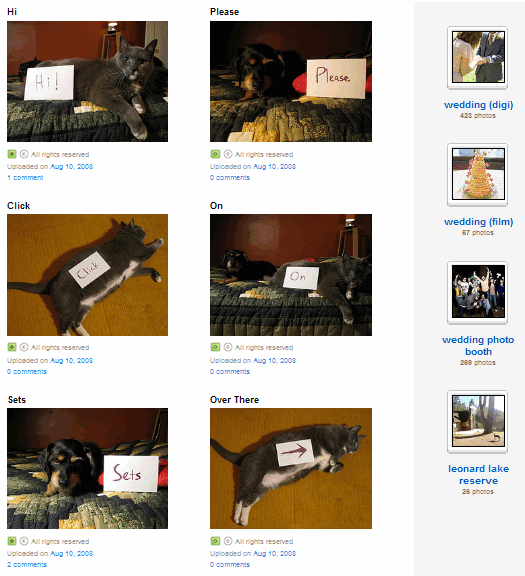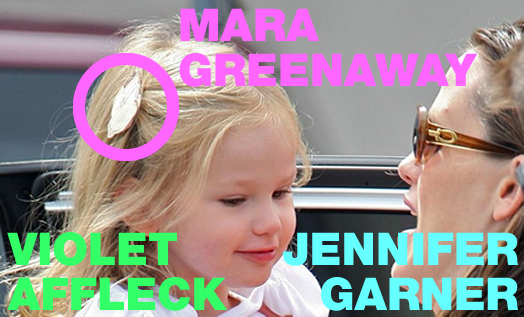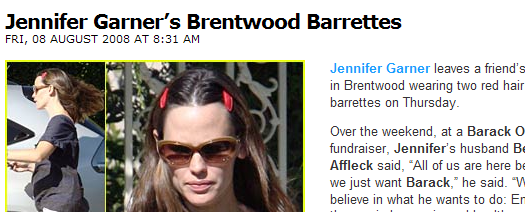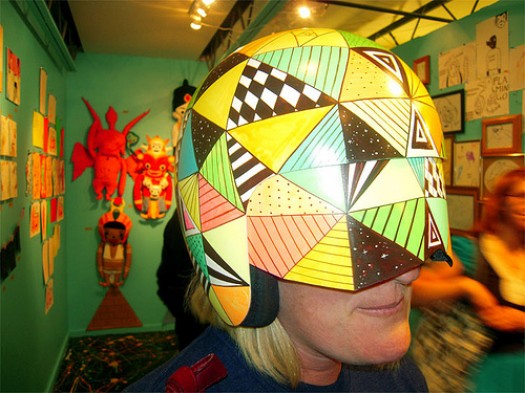Last night, Mara and I were messing around with Google Maps, checking out giant Japanese buddhas from the air. [Check out this one in Kamakura, near Tokyo]. Then we decided to see what North Korea looked like, and we raced over the Pyongyang and suddenly found this crazy thing with a giant triangular shadow. What the?Turns out that it's the Ryugyong Hotel. It has 105 stories, and it is indeed shaped like an arrowhead, with a broad base that tapers steeply to a pointy top. The craziest thing: It was abandoned in the mid-80's, during construction; hence its moniker: the Hotel of Doom. (Apparently, North Korea had already sunk 2% of its GDP into it when they decided to pull the plug. Ouch.)Esquire calls it worst-designed building in the world, which seems a little harsh. Would the world's worst-designed building inspire this: An animated short presenting a sort of Blade-Runner-meets-Disney-meets-Shinjuku vision for how the Ryugyong will be adapted in the future? Actually, maybe it would.See it for yourself here.
Last weekend, I had an unlikely opportunity: I was invited to sit on a panel that discussed the future of small literary presses, non-profit publishing, and — in general — books that took place at Coffee House Press in Minneapolis. I love books, reading, and non-corporate media, so I jumped at the chance to talk about this stuff in public. You may ask: Why me? I have a person on the inside who knows that I like to talk.1 My fellow panelists were a murderer's row of publishing insight. Rick Simonson is the co-founder of Copper Canyon Press and a book buyer at the Elliott Bay Book Company in Seattle; Richard Nash is the publisher of Soft Skull Press; Patricia Wakida runs Wasabi Press; and, Michael Coffey is the Managing Editor at Publisher's Weekly (and the author of an excellent baseball book, 27 Men Out).When we got started, I suspected I'd been tossed in a shark tank wearing a meat necklace. I found myself rattling on about things in my frame of reference — technology, social media, iPhones, Kindles, stuff wanting to be free — and I worried that all of it was simply chumming the waters for my fellow panelists who (a) know a lot about publishing, and (b) clearly recognized that their business models are being eroded by technologies that offer new ways to read (i.e., everything with a screen) and supply chain disintermediation, i.e. Amazon.
Side note: The weather was beautiful
 Whenever I take a picture of him, Fish (i.e., Chris Fischbach of Coffee House) tells me: "I better not see this on the Internet." But I just had to take this one while he and Katie (of Graywolf and New York Times fame) took me on an excellent walk along the Mississippi just before winter arrived.
Whenever I take a picture of him, Fish (i.e., Chris Fischbach of Coffee House) tells me: "I better not see this on the Internet." But I just had to take this one while he and Katie (of Graywolf and New York Times fame) took me on an excellent walk along the Mississippi just before winter arrived.As it turned out, we had a series of productive conversations. My colleagues and the audience were keen to know about how companies go about determining the right way to conceive technological products, and to implement them appropriately. Meanwhile, I learned a lot about small presses, publishing, and the ways that editors at literary presses think about their work. Allan Kornblum, the founder of Coffee House Press, saw himself as "the inheritor of the Maxwell Perkins tradition" in creating deep and lasting relationships with artists, supporting them and providing a consistent venue for publication. Fish said that he wanted "to create art objects that last." Both of those goals make a lot of sense to me, and they seem like a firm foundation for a business in transition.
So, what is the future of reading, anyway?
I'm going to put together another post about my thoughts on this topic, and in the meantime I'm going to be digesting some of the work that my fellow panelists referenced during our discussions; this list includes Ursula Le Guin's "Notes on the alleged decline of reading" that I saw in Patricia's pile of notes; Michael mentioned Bill McKibben's new book, Deep Economy in making a comparison between regional literature and a larger movement toward regional and local economies; Richard spoke a couple of times about literary subscription programs, such as Soft Skull's annual edition, and Powell's indiespensable list. 1 I was there because my friend Fish (the senior editor at Coffee House Press) thought that my experience with technology and online product strategy would complement the deep expertise of the small press luminaries on the panel. Or perhaps he just wanted to see what happened when I said the words "Kindle" and "free" around Michael Coffey. In the end, there would be no way of knowing.
Long ago, someone spray painted "US out of North Dakota" on the wall of the Cave, a little bar in the basement of a Carleton dorm. It was directly above the stage, a stage where I saw a lot of good bands (Walt Mink, FIREHOSE, Phish, and probably others). So I spent a lot of time staring at it. It made a deep impression on me. I still think about it. Which reminds me: Secession. The counties of Northern California and Southern Oregon tried to secede from their respective states in the 40's. True story. So anyway, it makes me really happy that Justin took this photo of a Duster in his neighborhood in Berkeley. Dissent! It's your patriotic duty.
We have a house guest this week, and we've been doing a lot of hanging out while reading and listening to music. Last night, the discussion turned to Auto-Tune, and it quickly revealed the beauty of being at least somewhat Internet-literate.
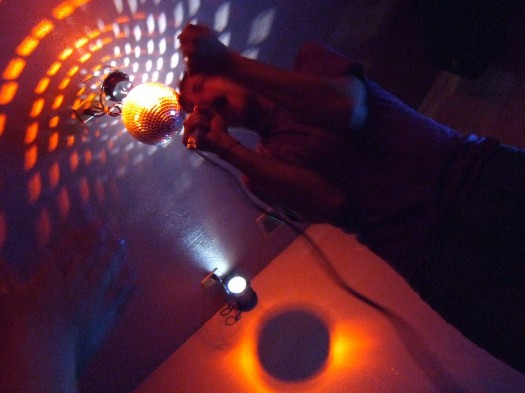 Speaking of Internet-literate, this is our houseguest: Dave.
Speaking of Internet-literate, this is our houseguest: Dave.It started with Lil Wayne. I mentioned to Mara and Dave that Stereogum has an irritating post about Lil Wayne's use of Auto-Tune on SNL. It was irritating because, to me, there's a difference between using Auto-Tune to compensate for your own inability to hit the notes (e.g., Kelly Clarkson in "Since U Been Gone"), and using it to increase the funky quotient, as Lil Wayne does in "Lollipop." Anyway, Dave recalled a Pitchfork interview with Neko Case in which she has some salty words on the subject of Auto-Tune. [tappity-tappity]
Neko Case: When I hear Auto-Tune on somebody's voice, I don't take them seriously. Or you hear somebody like Alicia Keys, who I know is pretty good, and you'll hear a little bit of Auto-Tune and you're like, "You're too fucking good for that. Why would you let them do that to you? Don't you know what that means?" It's not an effect like people try to say, it's for people like Shania Twain who can't sing.
(It gets even saltier). Then the conversation turned to Auto-Tune's first major splash, which was recently discussed in a Sasha Frere-Jones piece in the New Yorker [tappity-tappity]
The first popular example of Auto-Tune's distorting effect was Cher's 1998 hit "Believe,†produced by Mark Taylor and Brian Rawling. During the first verse, Auto-Tune makes the phrase "I can't break through†wobble so much that it's hard to discern.
Of course, then we had to hear "Believe," so Dave suggested Favtape. [tappity-tappity] Bingo; briefly, we revisited 1998. Then, it seemed like it made sense to listen to Bedhead's cover as well. [tappity-tappity] It features a touch-tone phone as an instrument.So what's the story with using Auto-Tune on "Believe?" Did the producers seek it out because Cher couldn't hit the notes, or did they just want to get funky? [tappity-tappity] The Internet has your answer, sort of. It's from a 1999 article in the British magazine Sound on Sound, but the problem is that the producers don't admit to using Auto-Tune; it was still a trade secret at that point:
The … obvious vocal effect in 'Believe' is the 'telephoney' quality of Cher's vocal throughout. This idea came from the lady herself — she'd identified something similar on a Roachford record and asked Mark if he could reproduce it.He explains, "Roachford uses a restricted bandwidth, and filters the vocals heavily so that the top and bottom ends are wound off and the whole vocal is slightly distorted. It took a while to work out exactly what it was that Cher liked about this particular Roachford song, but in the end we realised it was the 'telephoney' sound. I used the filter section on my Drawmer DS404 gate on the vocal before it went into the Talker to get that effect."
Actually, we now know the truth. It was Auto-Tune. All of this happened in about 15 minutes; we explored the arc of Auto-Tune in popular songs, with examples of early incarnations and deep discussion about how and why it was applied. Nice. [tappity-tappity]
I've always loved Haruki Murakami. I share his tastes in music — Miles Davis, the Rolling Stones — and I'm easily taken in by his smoky bars, rainy nights, noir pacing, puzzling plot twists, and spare, reserved prose. His books are filled with cool, crisply imagined situations that are eerily layered with shadows and mystery, and that shift subtly between reality and surreality, between the natural and the supernatural. Recently, it was revealed that he is a runner, like me, when he released a book of ruminations on running and its effects on his life and writing. It's called What I Talk About When I Talk About Running, and it is easily in my personal tops of the pops for 2008.There was something about his writing that struck a deep chord with me, but the nature of it was not revealed until he described a specific moment of "passing through" during an ultra-marathon. People talk about "hitting the wall," but, in my experience, running is about hitting many walls, and somehow emerging on the other side.
… Around the 47th mile I felt like I'd passed through something. That's what it felt like. Passed through is the only way I can express it. Like my body has passed clean through a stone wall. At what exact point I felt like I'd made it through, I can't recall, but suddenly I noticed I was on the other side. I don't know about the logic or the process or the method involved — I was simply convinced of the reality that I'd passed through.
Once I read that, I started to remember other moments in Murakami books, moments that all of a sudden seemed to spring from his running experience. For instance, there's a scene in The Wind-Up Bird Chronicle when Boku descends into a well to try to pass through its stone wall to find his missing wife, Kumiko, in a room on the other side of the wall:
I try to separate from myself … I try to get out of the clumsy flesh of mine, which is crouching here in the dark. Now I am nothing but a vacant house, an abandoned well. I try to go outside, to change vehicles, to leap from one reality to another that moves at a different speed. Now a single wall is the only thing separating me from the strange room. I ought to be able to pass through that wall. I should be able to do that with my own strength and with the power of deep darkness in here.
Later, he breaks through.
All of a sudden, I was asleep, as if I had been walking down a corridor with nothing particular on my mind when, without warning, I was dragged into an unknown room. How long this thick, mudlike stupor enveloped me I had no idea. It couldn't have been very long. It might have been just a moment. But when some kind of presence brought me back to consciousness, I knew I was in another darkness.
That sense of being changed "without warning" is so recognizable; I feel like I've been on long runs in which I'm transported suddenly, through time, and dropped somewhere else. And the part about "another darkness" reminded me of After Dark, when Eri Asai has somehow passed from an actual bed to a bed on a TV screen that faces the actual bed, a similar situation in which the rules were somehow totally different:
In the bed in that other world, Eri continues sleeping soundly, as she did when she was in this room — just as beautifully, just as deeply. She is not aware that some hand has carried her (or perhaps we should say her body) into the TV screen. The blinding glare of the ceiling's fluorescent lamps does not penetrate to the bottom of the sea trench in which she sleeps.
All of these make more sense now. It's all about breaking through, about transcending something that is both physical and mental, even spiritual. I also loved Murakami's running mantra: "I'm not a human. I'm a piece of machinery. I don't need to feel a thing. Just forge on ahead." It reminded me of my own mantra, which is the final verse of Johnny Cash's Folsom Prison Blues:
Well, if they freed me from this prison,If that railroad train was mine,I bet I'd move it on a little,Farther down the line,Far from Folsom Prison,That's where I want to stay,And I'd let that lonesome whistle,Blow my Blues away.
Running: It's all about pain, machines, escape, and breaking through walls.
What we have here is both a failure to communicate and an ingenious workaround. To Kristen & Rob: Kudos.
The classiest fam in Hollywood loves Mara's barrettes; this time Violet rocks them. Nice. Buy em here, and pass it on.
File this one under: Holy crap. It has come to the attention of the tabloid-reading world that Jennifer Garner was seen wearing red barrettes! But, wait, there's more. A certain barrette-making friend of ours made them. By hand. In San Francisco.
This is from Just Jared, and I must say: If the blog really is just a guy named Jared writing about celebrities, my hat is off to him. He publishes some tidbit of celebrity gossip roughly every 5 seconds. That's dedication, homes. If you're interested in the barrettes, you can buy a pair for yourself at Little Something; if you're concerned that they'll make you look like Jennifer Garner, you can ask Mara for some guidance in the proper way to wear them.

I'm glad that the barrettes got the full paparazzi treatment. A couple of photos just wouldn't have been sufficient. Better get 17 and be safe. Check em all out.(Congratulations, you big loser).
I could use one of these right about now. Via these geniuses.
Yeah / Yoshi's Gourmet steez
A couple of weekends ago, I visited the site of an Airstream trailer that Yoshi and I shared outside Stinson Beach, California. The trailer is long gone, but the spot is still the same: Overlooking the Pacific Ocean on a scraggly lawn at the end of a farm road. We spent many a night sitting on a homemade couch out under the stars, listening to a crusty Crooked Rain, Crooked Rain cassette, hanging out with farm people, and generally being our best wild selves. They were simpler times, so the wildness was simpler. One time, police showed up and asked Yoshi if he knew anything about the ritual animal sacrifices happening in the area. Naked toddlers often woke him up by tickling his eyelashes with wildflowers.
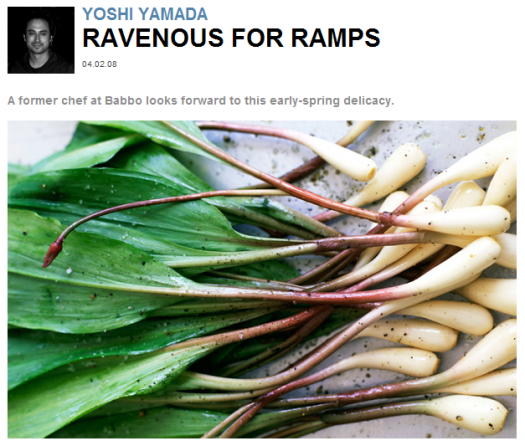 Look at our boy now! Gourmet Magazine. Articles about obscure vegetables. Lunches, brunches, interviews by the pool. What's next? Condos in Queens? Indo for weeks? Sold out seats to hear Yoshi Yamada speak?
Look at our boy now! Gourmet Magazine. Articles about obscure vegetables. Lunches, brunches, interviews by the pool. What's next? Condos in Queens? Indo for weeks? Sold out seats to hear Yoshi Yamada speak?The article is vintage Yamada, reminding me of the many excellent, excellent letters and postcards that I've accumulated over the years:
I have not put ramps in my pipe, but I have smoked them and also roasted, sauteed, blanched, pickled, braised, and pureed them. I have eaten them raw and dirty, and I have cleaned so many in a row that I almost wished for winter again. This year I may take a few home to put under my pillow, just because … my precious.
Not sure that I've eaten a ramp, but I bet they'd be tasty with a ritually sacrificed animal. Mmmmmmm ritual sacrifice.

